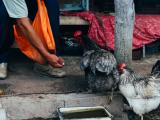May 25, 2006 (CIDRAP News) – Scientists investigating a family cluster of at least seven cases of H5N1 avian influenza have asked 33 close contacts to quarantine themselves at home in their North Sumatra, Indonesia, village, according to a Reuters report today.
In addition, a World Health Organization (WHO) official speculated that the first person in the cluster might have contracted the virus in a local market where she worked, according to the Associated Press (AP).
Meanwhile, in Bandung on the Indonesian island of Java, local health officials have confirmed that a 10-year-old girl who died May 23 tested positive for H5N1 avian flu, according to Reuters.
In North Sumatra, WHO spokesperson Dick Thompson told Reuters, "There are 33 people identified as close contacts. We've asked them to observe home quarantine. That's something they are willing to do to protect themselves and their families."
Thompson added, according to an Agence France-Presse (AFP) story today, "We will monitor them for a week or two to see if they become sick. If they do, they will immediately be put in isolation in a hospital." He said the 33 might be given oseltamivir (Tamiflu).
The cluster triggered speculation that the WHO might raise its pandemic alert status from phase 3 to phase 4, but no steps in that direction were reported today.
One of the major puzzles about the cluster, in which human-to-human-to-human transmission is suspected, is the lack of an identifiable animal source of infection for the first case. Steven Bjorge, a WHO epidemiologist in Jakarta, told the AP that the 37-year-old deceased woman who is regarded as the first case-patient might have picked up the virus in her home or workplace. She died April 29 and was buried before samples could be collected for testing, but the WHO believes her illness was avian flu.
"We believe she may have had some contact either with dead or dying chickens in her household or through her activities as a vegetable grower and a seller in a market," Bjorge said of the woman.
Bjorge described the Sumatra investigation as very thorough. "We are very concerned about this large outbreak, and we've taken it very seriously, as has the government," the AP quoted him as saying. "We want to find out if there is any possibility of even one person having mild symptoms that might have been overlooked."
In West Java, a 10-year-old girl and her 18-year-old brother were admitted to a hospital in Bandung earlier this week with avian flu–like symptoms, according to a Reuters report today. The girl died May 23, according to Reuters, but the status of her brother was unclear.
Nyoman Kandun, director-general of disease control for Indonesia's Ministry of Health, said that local tests revealed H5N1 infection in the girl, telling Reuters, "The younger one is positive. We are looking into the other one."
Local tests must be confirmed by tests in a WHO-affiliated laboratory to become official. For now, Indonesia's avian flu case count remains at 42 (25 in 2006), and its death toll is 33 (22 in 2006), second only to Vietnam, which has registered no human cases since November 2005, according to the WHO.
Iranian situation unclear
Elsewhere, the WHO today asked Iran to supply further details on the tests that were run on two dead patients in the northwestern city of Kermanshah, according to Reuters. An official at the treating university hospital in Kermanshah had said on Monday that tests on the two had revealed H5N1 avian flu, according to news reports.
But an Iranian health official denied that claim. "Fortunately," Health Minister Kamran Lankarani told Reuters May 23, "these two cases were negative for avian flu."
Samples from the two—a 41-year-old man and 26-year-old woman described as brother and sister—have been sent to labs outside Iran for confirmatory testing.
See also:
May 24 CIDRAP news story "Two generations of spread possible in Indonesia H5N1 cases"



















